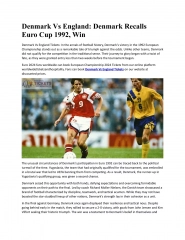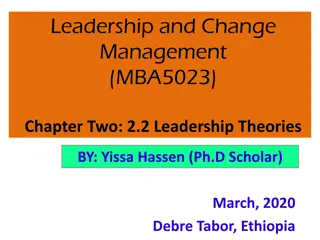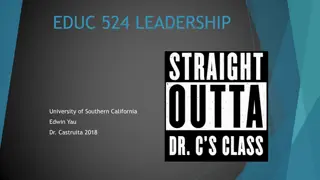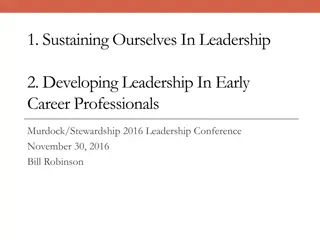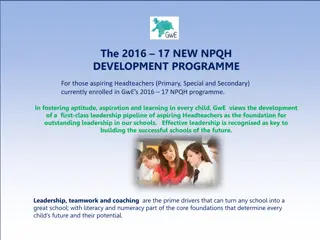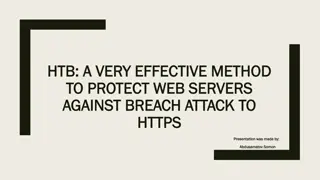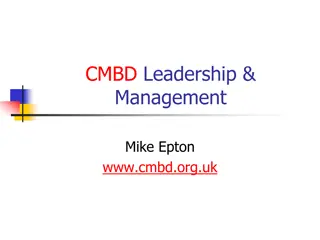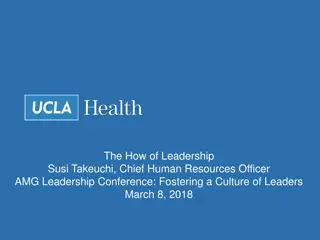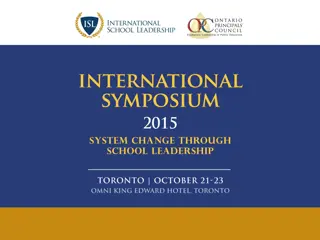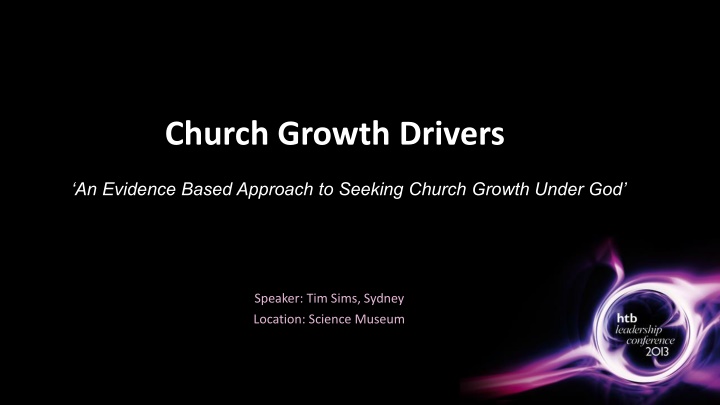
Evidence-Based Approach to Church Growth: Understanding Challenges and Effective Ministry
Explore the evidence-based approach to church growth under God, analyzing challenges, effective ministry strategies, and the decline in church attendance. Discover insights from systematic research, demographic trends, and the correlation between various factors impacting church dynamics.
Download Presentation

Please find below an Image/Link to download the presentation.
The content on the website is provided AS IS for your information and personal use only. It may not be sold, licensed, or shared on other websites without obtaining consent from the author. If you encounter any issues during the download, it is possible that the publisher has removed the file from their server.
You are allowed to download the files provided on this website for personal or commercial use, subject to the condition that they are used lawfully. All files are the property of their respective owners.
The content on the website is provided AS IS for your information and personal use only. It may not be sold, licensed, or shared on other websites without obtaining consent from the author.
E N D
Presentation Transcript
Church Growth Drivers An Evidence Based Approach to Seeking Church Growth Under God Speaker: Tim Sims, Sydney Location: Science Museum
DIAGNOSTIC FRAMEWORK 1. What are we really up against? 2. What should this mean for more effective ministry under God? 3. What real challenges do we face along the way?
SYSTEMATIC RESEARCH Literature Search: 120+ * Expert Interviews: 75+ Field Questionnaires: 42 Workshops 12 Beta sites 6 + National Church Life Survey data and research 1991 2011 *All initiatives considered in the context of Biblical theology
DECLINE IN REGULAR CHURCH ATTENDANCE * Percent attending monthly or more Catholic 80% Pentecostal 60% Uniting / Meth / Presb Anglican 40% 20% 0% 1950 1960 1970 1980 1990 2000 Source: Spirit Matters, AuSSA09, Australian Soul Bouma, * Australian national statistIcs
DEMOGRAPHIC DISASTER Percent of attendees 20% 15% 10% Large Established Denominations 5% 0% 15-19 % eq. 20-29 30-39 40-49 50-59 60-69 70-79 80 DOB @ 2006: 1991-87 1986-77 1979-67 1966-57 1956-47 1946-37 1936-27 >1927 Source: Church life profile p23 NCLS06, exceeds 100% based on optical adjustment to 15-19 year olds Note Australian average life expectancy 82
LAZY CHURCH: INTRIGUING CORRELATION Index 120% Attendance 92% Correlation 100% Births to stable marriages 80% 60% 40% 20% 0% 1954 1961 1966 1971 1976 1981 1986 1991 1996 2001 2006 Sources: ABS census data, Build my church p22 Note: The data does not demonstrate cause, only correlation
INSTUTIONAL ONSLAUGHT 1901 2006+ Millions of People 7 Anglican 6 Catholic National Institutions 5 Schools Other Religion 4 Not stated 3 Families 2 Individuals 1 0 1901 1911 1921 1933 1947 1954 1961 1966 1971 1976 1981 1986 1991 1996 2001 2006 Source: ABS Census Data
DISORGANISED / INEFFECTIVE RESPONSE Outreach Leadership Community Service Most Value Inspiring Ineffective planning & organisation Agree Follow Clear & Open Strongly Agree Always Look Aware & Engagement Small Groups Poor spiritual health 10% of Net Income Private Devotions Much Personal Commitment Personal Growth Sources: Church life profile NCLS01, NCLS06, DYB 2008, Numbers as at September 21st Note the score profile is very different in the youth ministry
LOGICAL RESPONSE UNDER GOD 1. What are we really up against? 2. What should this mean for more effective ministry under God? 3. What real challenges do we face along the way?
SOME RESEARCH OBSERVATIONS... 1. Large numbers are attending irregularly (40%) for special services (71%) 2. Newcomers best engage through normal church (67%) and a congregation member (29%) 3. There is huge churn in the population (36% every 5 yrs); moves break ties... 4. 100% of net new growth is from the young 5. Wastage rates among the youth can be huge (82%) 10 .
THE SOUL OF BRITAIN 1987 2000 The percentage of people: Seeing a pattern of events such that it was meant to be 29% 55% Having awareness of the presence of God 27% 38% Having awareness of answers to prayer 25% 37% Having awareness of sacred presence in nature 16%% 25% Having awareness of an evil presence 12% 25% Cumulative total (at least one mentioned) 48% 76% Source: Professor David Hay, Nottingham University, for the BBC series Soul of Britain
SURPRISING EXPOSURE Percent of Australians Attending in the Last Year 80% 71% 62% 60% 44% 40% 39% 38% 35% 40% 28% 22% 19% 17% 20% 10% 8% 0% Zoo Cinema Library Theatre Sporting Event Botanic Classical Music Special Church Dance Museum Opera / Musical Regular Church Art Gallery Service Service Source:ACS98 Why people don t go to church? p67, p42, p8, p80; Build My Church p11 * Special services on average 2.6X per annum
SURPRISING IMPLICATIONS Multiples of WASA X Per Annum 10.1x 12 6.1x 10 8 6 2.8x 4 0.6x* 1.0x 2 0.4x 0.8x 0 Weekly > Monthly Churched Visitors Non-Churched Visitors < Monthly Special Service At Least Once Sources: ABS, NCLS06, ACS98, based on nominal Anglicans at 19.5% of Sydney Adult population *Note: ~0.3X invited, Special Services on average 2.6 occasions. See back up on positive impact of Special Services
IMMEDIATE UPSIDE POTENTIAL > 4.5x 2. Greet / Meet / Integrate 3. Invitation Ministry + 1x + 2x + 1x 1. Discipling / Gospel Community 4. Transition Ministry +0.5x
WARNING: FALSE ACTIVITY One out of every four people at Willow Creek were stalled or dissatisfied with the church many were considering leaving. When I first heard these results the pain of knowing was almost unbearable Bill Hybels, 2007 Source: Reveal 2004 (6,000), Follow Me (80,000)
IMPLEMENTATION CHALLENGE 1. What are we really up against? 2. What does this mean for more effective ministry under God? 3. What real challenges do we face along the way?
CHOKE POINT Understand the Problem Develop a Credible Response Persuade for Change Establish the Need We have made progress and we are going better than most Success might lead to theological compromise Unease over personal effort and the sovereignty of God Visible political pressure at the congregational level Ambivalent congregations Personal risk in a narrow career structure Perceived long run ability to survive diminished performance Disparate congregation histories and circumstances Short term performance pressures Lack of clear evidence based research and conviction Very different personal gifts and experiences Anecdotal authority Well meaning inclusive complexity Lack of planning confidence and experience Entrenched conservatism under pressure Fragile unit, conflict and natural risk reluctance Lack of organisational know how and experience Overwhelming diary pressures Voluntary and part time delegation structures
RESULTING STRESS CAN BE HUGE % of Variance Explained * Extreme Burnout 4% Major Stress Drivers Not An Issue 21% Burnout Is An Issue 19% Personal Satisfaction 35% Congregational Conflict 22% Family Conflict 19% Personal faith growth 18% Setting Direction 18% Confidence in the Goal 18% Leadership Isolation 17% Strains of the Role 16% Borderline To Burnout 56% Planning and Vision 12% Personal Finances 10% Source:NCLSLS96 Burn out in church leaders * Numbers include co-variance and add up to >100%
DIARIES ARE FULL Hours 70 60 56 Hours + 50 Small Groups Pastoral Meetings 40 30 Admin 20 Church Services 10 Sermon Prep 0 Average Hours Per Week Source: Diary Analysis (14)
SET PRIORITIES 2. Greet / Meet / Integrate 3. Invitation Ministry + 1x + 2x + 1x 1. Discipling / Gospel Community 4. Transition Ministry +0.5x
ORGANISE AND EMPOWER Gospel Community Growing Leaders Worship Invitation Engage Grow Train Reach Out Early Morning Full time Mid Morning Part time Evening Youth Scripture Teaching Volunteer Plant 1 Plant 2 Volunteer <8 hours, Part time 8-30, Full time 30+
CONCLUSIONS 1. What are we really up against? 2. What should this mean for more effective ministry under God? 3. What real challenges do we face along the way?
A TIME FOR ACTION In the whole of world history there is always one really significant hour - the present if you want to find eternity you must serve the times Dietrich Bonhoeffer www.effectiveministry.org 23
ORDINARY CHURCH, THE ENTRY POINT First Occasion at Church 100% 80% All attenders 80% 67% Newcomers 60% 40% 20% 11% 8% 6% 6% 5% 4% 3% 3% 2% 2% 2% 1% 0% Ordinary Service Christmas / Easter Small Group Social Function Outreach Activity Baptism / Wedding / Funeral Other Adjusted for non-participants Source: Mission Under The Microscope
FAMILY AND ORDINARY MEMBERS KEY Most Significant People in Finding Faith 60% All attenders 41% Newcomers 40% 29% 23% 20% 12% 11% 11% 10% 10% 9% 9% 8% 7% 7% 5% 4% 4% 0% Parents Spouse / Other Family Workmates / Friends Sunday School Teachers People - This Church People - Other Church Other People No-one / Don't Know Adjusted for non-participants Source: Mission Under The Microscope
POPULATION CHURN IS HIGH Council Area Examples In from Australia In from Overseas Out to Australia Have Moved Percent movement 80% 57% 60% 36% 40% 27% 25% 17% 16% 20% 7% 6% 5% 0% -20% -14% -18% -40% -34% Fairfield Manly Simple average Sources: Council Records, Winds of change p350, NCLS91
RELOCATION A CHALLENGE AND AN OPPORTUNITY Reasons Left Previous Congregation 80% Switchers Transfers Returnees 70% 60% 53% 40% 20% 0% Moved Married Unhappy With Style Unhappy With Theology Needs Changed Conflicts / Unhappy With Leader Other Source: NCLS91 Winds of change p249-251, NCLS96 Build my church p 39, Anglicans and Protestant only.
INVITATION HAS REASONABLE ODDS Willingness to Accept an Invitation Likelihood of Becoming Frequent 60% 60% 52% 44% 40% 40% 32% 22% 20% 20% 16% 14% 9% 8% 3% 0% 0% Yes Unsure No None of my family / friends go Very Likely Somewhat Likely UnsureSomewhat Unlikely Very Unlikely Source: ACLS98, see appendix slides 60,61
YOUTH IS A VITAL PLATFORM New / New New / Returning In-house Regulars Drifters Estimated Headcount Per Age Year Home Grown 1000 New Christians 800 600 400 200 0 -200 Transitional Loss -400 0-14 15-19 20-29 30-39 40-49 50-59 60-69 70-79 80+ Sources: NCLS profiles 2001,2006; Why people don t go to church p23;DYB p144 30
OFTEN POORLY MANAGED Dropout Rate % Secondary / Post School Left Home Uniting 37% 45% Anglican 33% 43% Presbyterian 29% 33% Baptist 20% 32% Lutheran 13% 19% Adventist 9% 29% Methodist 8% 29% Reformed 5% 13% Source: Mission under the Microscope p121 NCLS91
THE EFFECT OF ALPHA ON CHURCH ATTENDANCE % of Churches (1989 1998) Grew 80% Stayed The Same Declined 60% 40% 20% 0% Non-Alpha 1-2yr Alpha 3yr+ Alpha
DAILY DEVOTION 10 Year Growth Step % 40% R2 90% Pentecostal 20% Baptist Churches Of Christ 0% Anglican Lutheran -20% Uniting -40% 40% 60% 80% Daily Bible Devotion % Source: NCLS91, NCLS96, NCLS06


